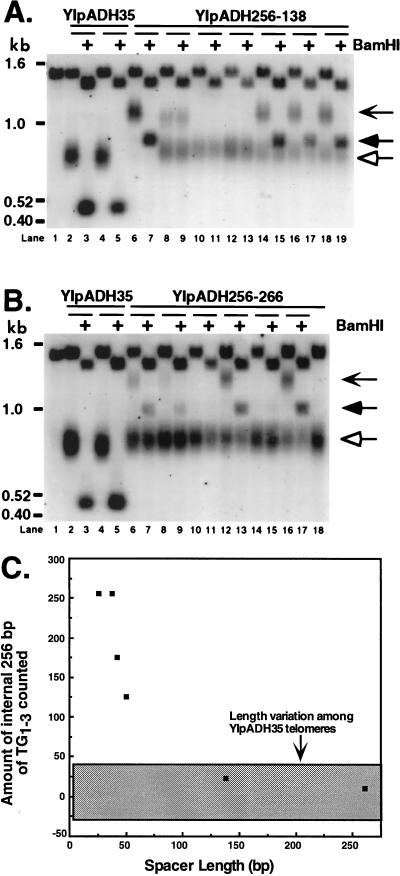FIG. 3.
A 138-bp nontelomeric spacer establishes a new telomere-nontelomere junction. (A) Individual YM708 transformants bearing the YIpADH256-138 telomere were analyzed as for Fig. 2. Lanes 6 and 7, a YIpADH256-138 transformant with long telomeres; lanes 10 to 13, transformants with short telomeres; lanes 8 and 9 and 14 to 19, transformants with short and long telomeres. The transformant in lanes 8 and 9 had lost the BamHI site in the long telomeres and was not used for the analysis in panel C. The chevron-headed arrow indicates the long telomeres, the filled arrowhead indicates the StuI-BamHI long telomere fragment, and the hollow arrowhead indicates the short telomeres. Lane 1 contains DNA from the untransformed strain. (B) Individual transformants bearing the YIpADH256-266 telomere were analyzed as for Fig. 2. Lanes 10, 11, 14, 15, and 18 show transformants with short telomeres, while lanes 6 to 9, 12, 13, 16, and 17 show transformants with short and long telomeres. Arrows are used as in panel A. Lane 1 contains DNA from the untransformed strain. (C) The amount of the internal 256-bp tract counted as part of the elongated TG1-3 tract plotted against the length of the nontelomeric spacer. The gray box represents the length heterogeneity due to normal variation and was calculated by using seven independent YIpADH35 telomeres. The amount of internal TG1-3 counted was determined by subtracting the average length of the terminal TG1-3 tract distal to the BamHI site for different nontelomeric spacer telomeres (the ? in Fig. 2A) from the average modal length of the TG1-3 tract for the control YIpADH35 telomere (Fig. 2A). The standard error of the telomere length measurements for each spacer telomere was ±10% except for YIpADH652-42 (±53%).

